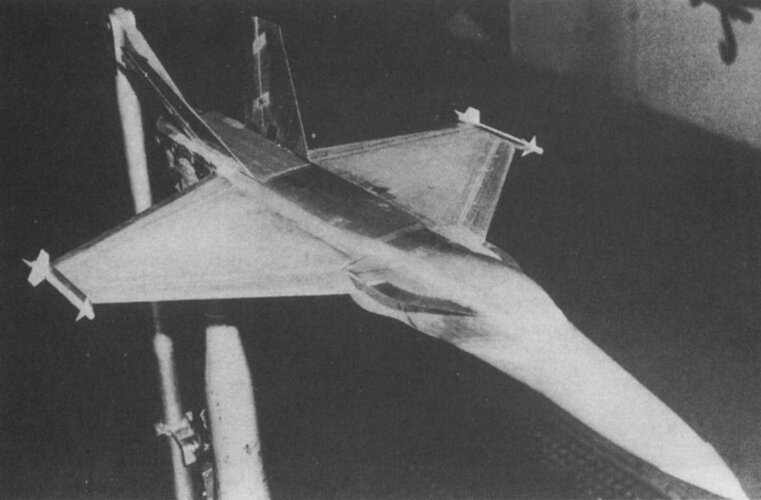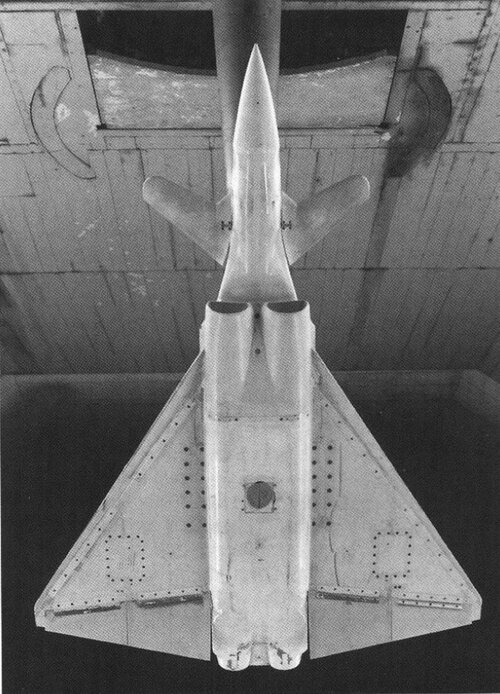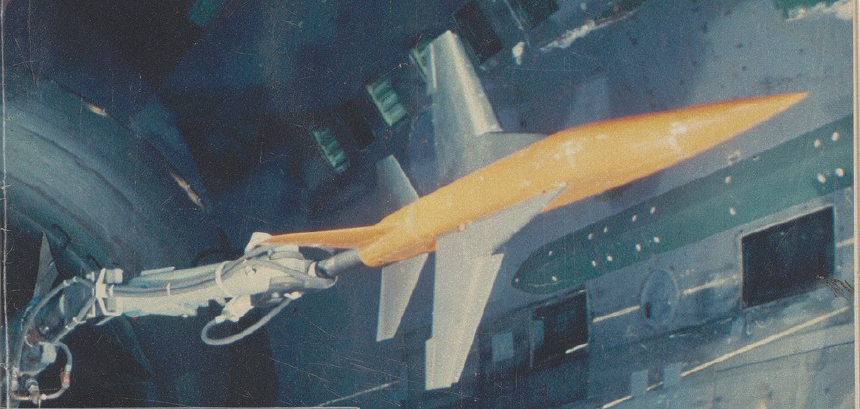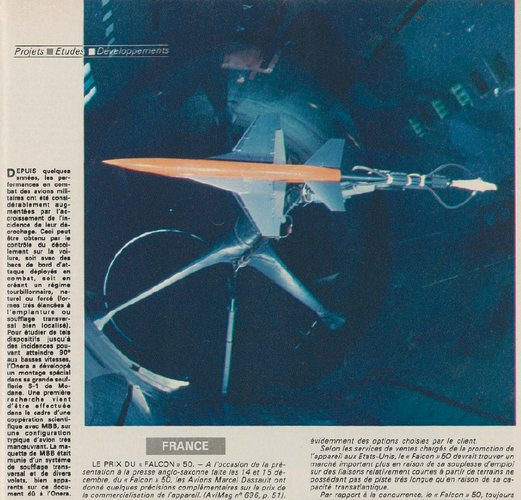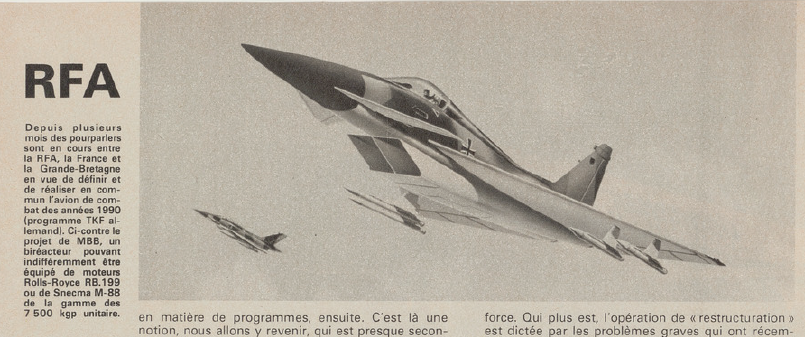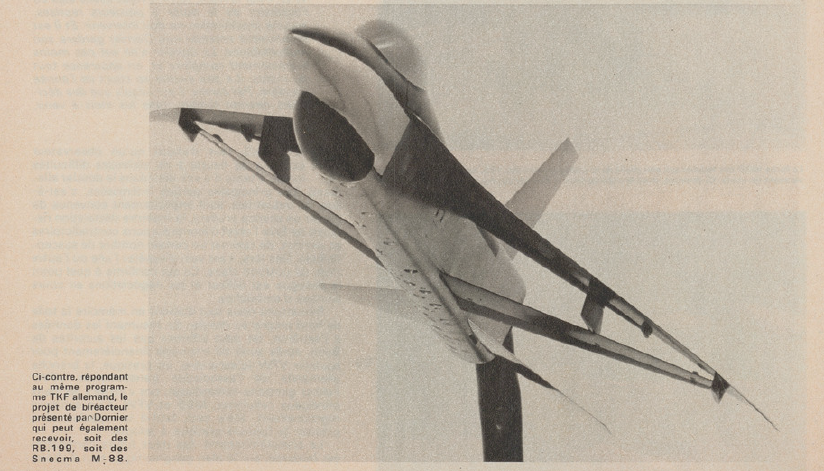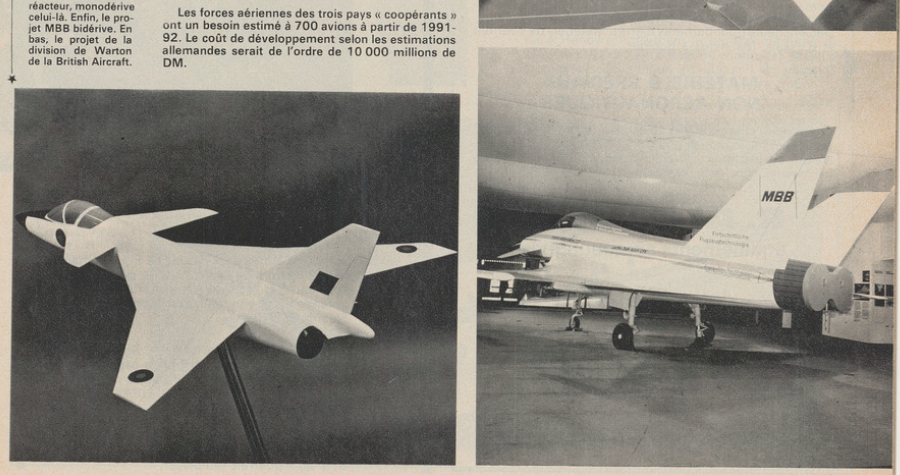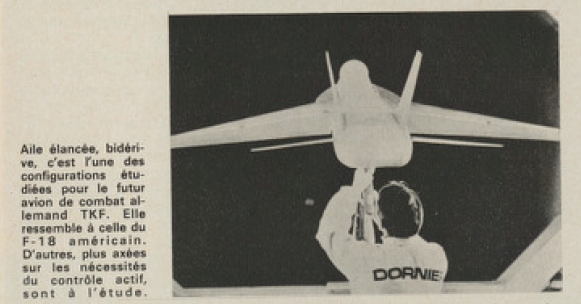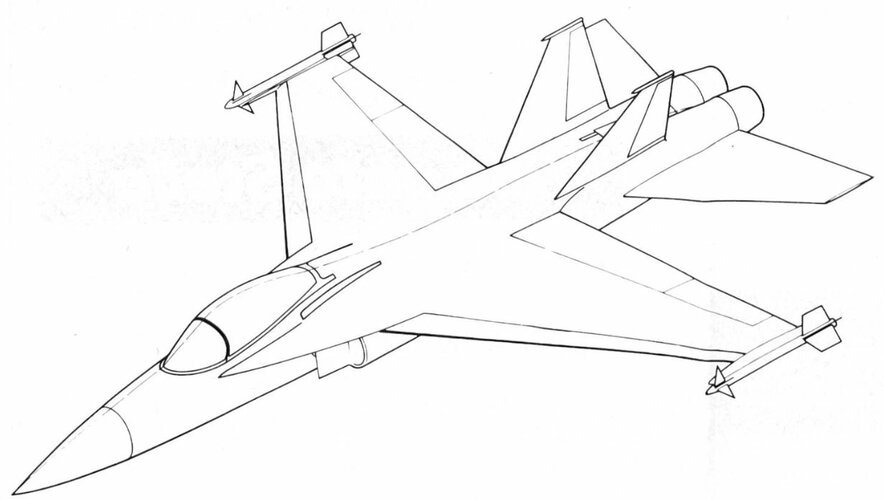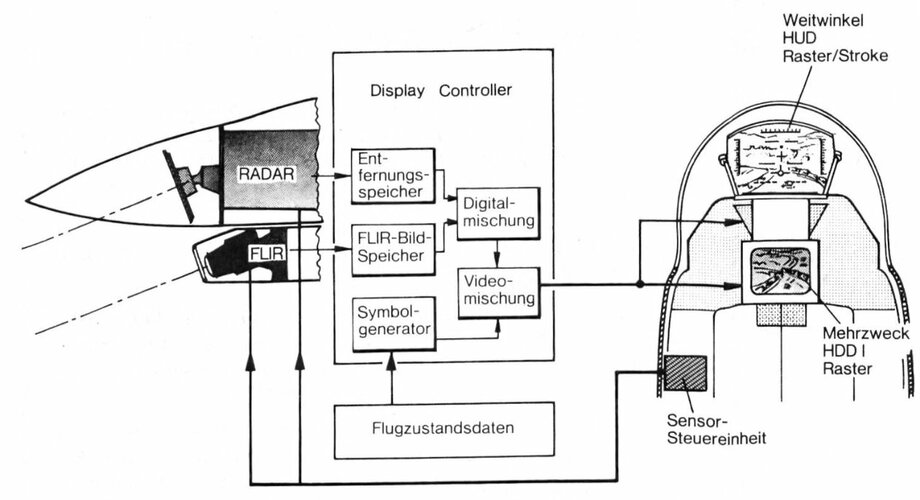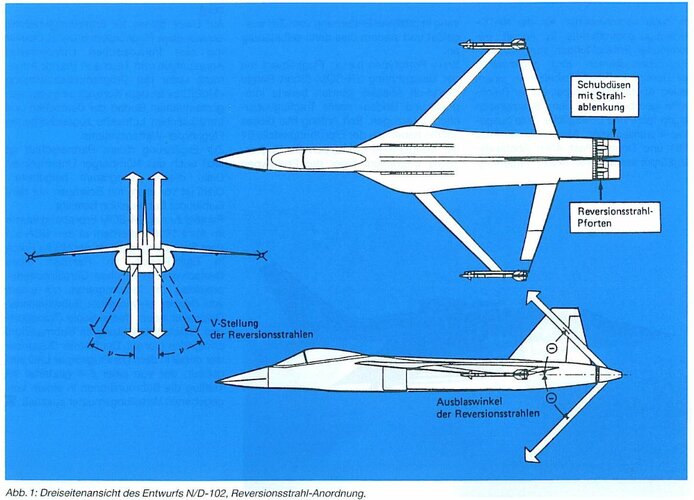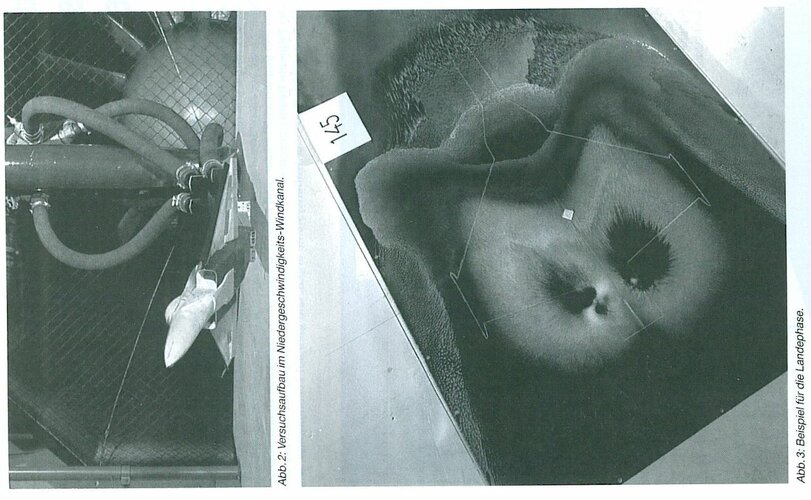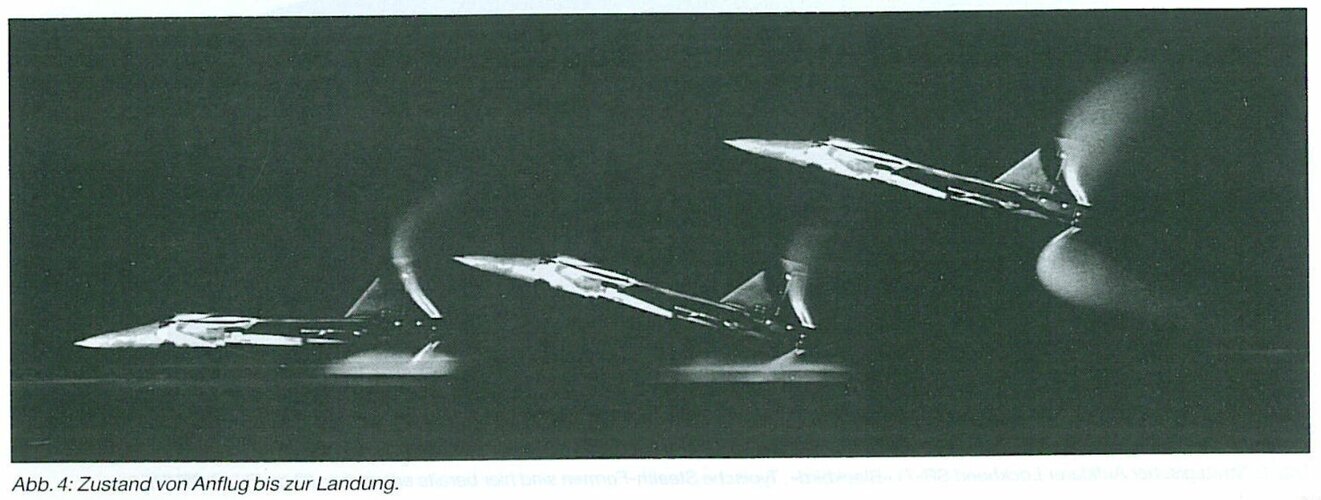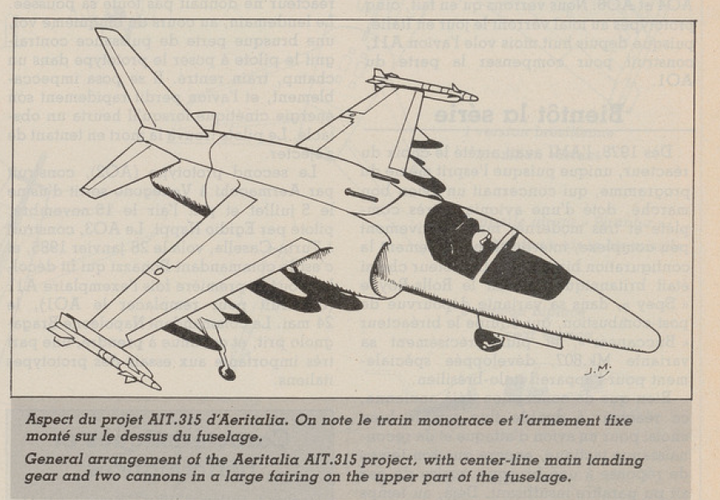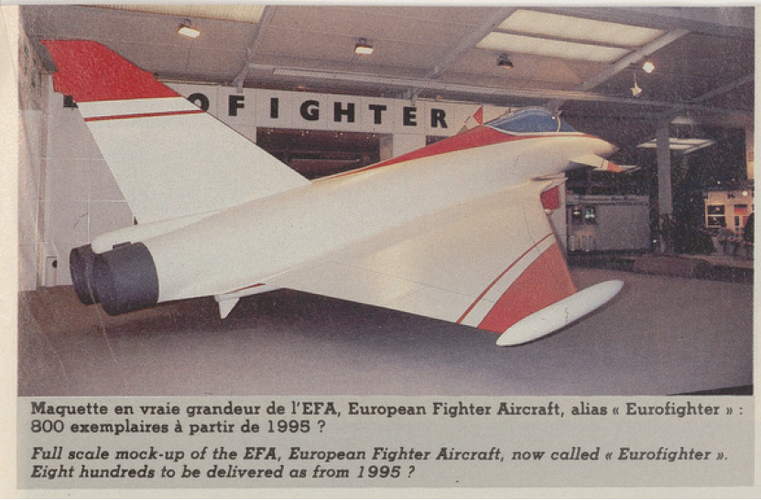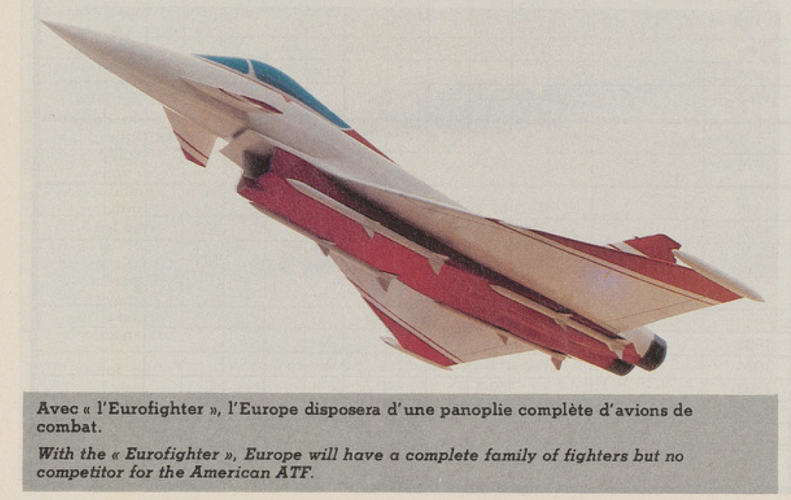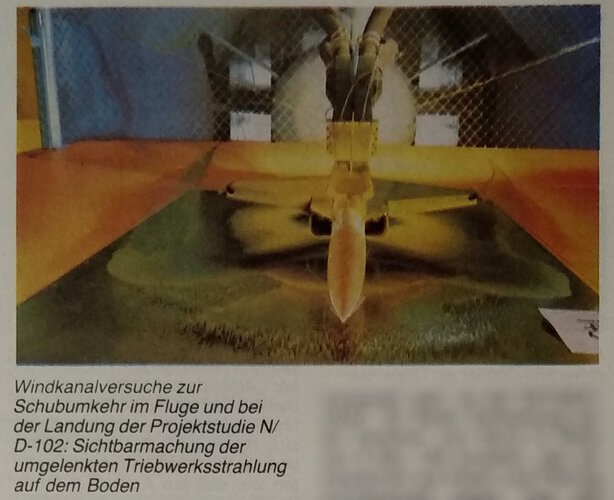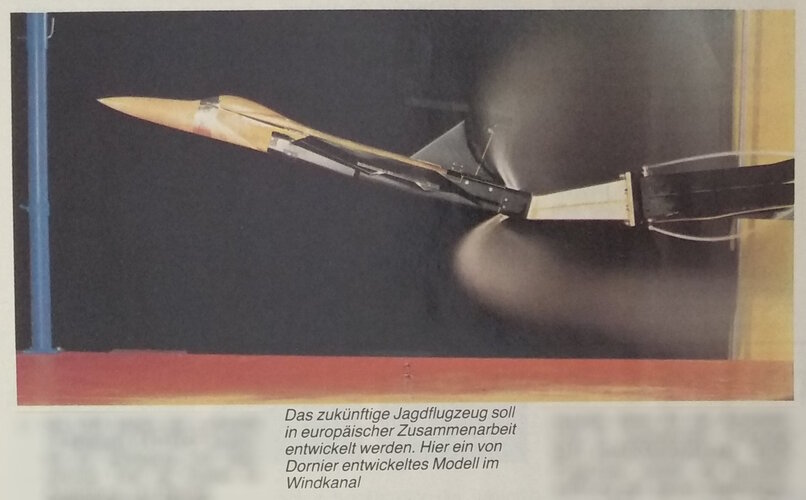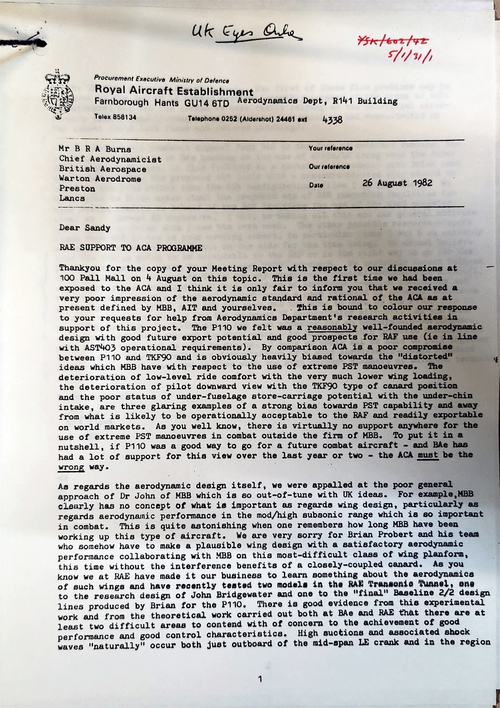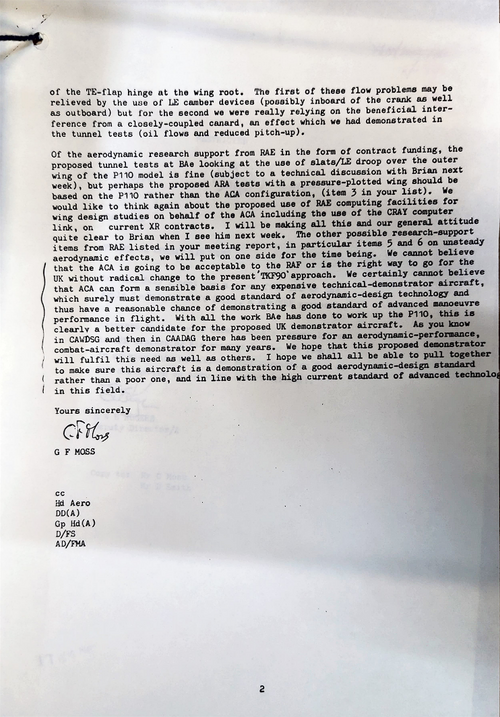You are using an out of date browser. It may not display this or other websites correctly.
You should upgrade or use an alternative browser.
You should upgrade or use an alternative browser.
Evolution of the Eurofighter Typhoon: TKF-90, AST 396, AST.403 and more
- Thread starter overscan (PaulMM)
- Start date
-
- Tags
- 1980s 1990s aeronautica militare british aerospace plc cold war dornier flugzeugwerke federal republic of germany france future european fighter aircraft programme great britain italian republic kingdom of spain luftwaffe messerschmitt-bölkow-blohm north atlantic treaty organisation post-cold war royal air force royal spanish air force vfw-fokker western europe
shedofdread
ACCESS: Top Secret
- Joined
- 14 November 2009
- Messages
- 593
- Reaction score
- 400
IIRC, they weren't using it to achieve VTOL but more an extreme STOL so *maybe* some of the issues wouldn't be as extreme. Not really sure why but the P.103 has always appealed to me. Maybe I just like a challenge......On the BAe P103 given that the Bell XF109 and VJ101C had shiwn the risks of this tilt engine approach why did BAe think it was workable?
What was the reason behind resignation from double vertical stabilizers in Eurofighter?
Many EF prototypes had double stabilizers. And final EF has somewhat restricted high AoA regime due to having single vertical stab.
Plus canted stabs will give smaller radar reflection from the side.
It was due to financial reasons or there was some aerodynamics behind this decision?
Many EF prototypes had double stabilizers. And final EF has somewhat restricted high AoA regime due to having single vertical stab.
Plus canted stabs will give smaller radar reflection from the side.
It was due to financial reasons or there was some aerodynamics behind this decision?
- Joined
- 27 December 2005
- Messages
- 17,752
- Reaction score
- 26,437
This decision was first explored on the ACA / EAP.
Warton (BAE) did extensive trade studies on one versus two tails in 1982 and felt the performance benefit to the ACA configuration was minimal and outweighed by additional weight and compexity. High alpha capability was an MBB obsession and not a major concern for BAE or the RAF.
For EAP the initial plan was MBB doing centre fuselage and vertical tails, and AIT the rear fuselage, but then BAE had to take these over when the other partner nations cut funding and went with largely Tornado rear fuselage including a single Tornado fin. It worked well enough on EAP.
When EFA design was finalised, two versus one tails was re-examined again, but the same conclusion was reached as before. For the given requirements, low drag and weight and adequate stability was the right solution.
Warton (BAE) did extensive trade studies on one versus two tails in 1982 and felt the performance benefit to the ACA configuration was minimal and outweighed by additional weight and compexity. High alpha capability was an MBB obsession and not a major concern for BAE or the RAF.
For EAP the initial plan was MBB doing centre fuselage and vertical tails, and AIT the rear fuselage, but then BAE had to take these over when the other partner nations cut funding and went with largely Tornado rear fuselage including a single Tornado fin. It worked well enough on EAP.
When EFA design was finalised, two versus one tails was re-examined again, but the same conclusion was reached as before. For the given requirements, low drag and weight and adequate stability was the right solution.
Last edited:
F-2
ACCESS: Top Secret
- Joined
- 22 May 2020
- Messages
- 887
- Reaction score
- 1,725
Hey! I don’t know if anyone knows, but I’m really interested in the 1986 farnborough mock up. It seems close to the final design, anyone know how it differs, does anyone have a three view? I’ve heard it might have been the P.120 but I’m not sure that’s the case. Since the EAP only first flew a month before and provided vital test data I assume it must have been revised in someway, but how?
F-2
ACCESS: Top Secret
- Joined
- 22 May 2020
- Messages
- 887
- Reaction score
- 1,725
Some video of the 1986 mock up
The timing seems very odd generally from what I’ve seen is that you have a mock up either when your about to cut metal or about to sell someone on a configuration. Generally it’s three years or so from mock up to final. Yet I don’t think physical work on the eurofighter started till 1989, prototype done in early 1992 and almost two years before the first fight (which is also kinda odd) 1986-1989 seems like kind of a black hole.
also a web archive of an old article that had a dead link https://web.archive.org/web/2014052...ch='Bae P 120'&scrollbar=0&page=1&view=FitH,0
- Joined
- 27 December 2005
- Messages
- 17,752
- Reaction score
- 26,437
I'm not really understanding your argument.View: https://m.youtube.com/watch?v=SqOu0JuH_-g
View: https://m.youtube.com/watch?v=4oE2pc4hi-I&t=2107s
Some video of the 1986 mock up
The timing seems very odd generally from what I’ve seen is that you have a mock up either when your about to cut metal or about to sell someone on a configuration. Generally it’s three years or so from mock up to final. Yet I don’t think physical work on the eurofighter started till 1989, prototype done in early 1992 and almost two years before the first fight (which is also kinda odd) 1986-1989 seems like kind of a black hole.
also a web archive of an old article that had a dead link https://web.archive.org/web/20140520093941if_/http://www.flightglobal.com/FlightPDFArchive/1985/1985 - 1541.PDF#navpanes=0&search='Bae P 120'&scrollbar=0&page=1&view=FitH,0
Mockups are made for various reasons at various times. Sometimes they are highly classified at the time, and presented only to the customer Air Force and never displayed in public. The EFA mockup in 1986 was a sales tool. EFA was going in circles, BAE in particular were trying to get something going. EFA mockup in 1986 showed roughly the then-current EFA config - I have an official drawing from May 1986 which exactly corresponds with this painting:
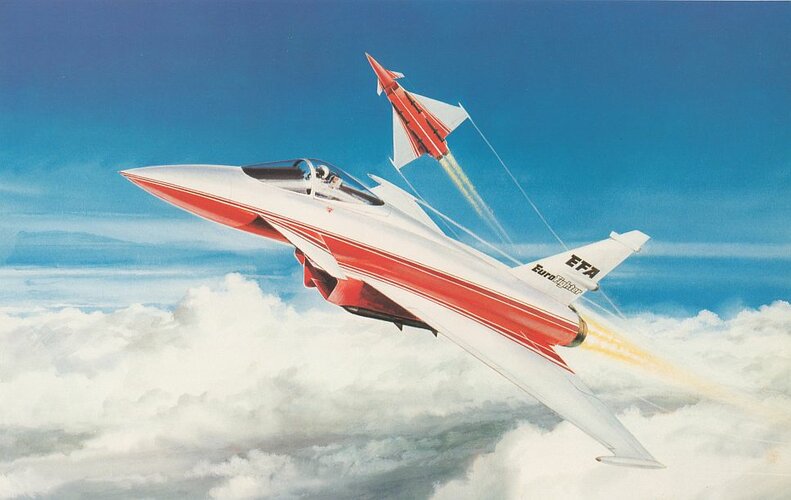
Its a stepping stone between EAP (originally "Experimental Aircraft for the Agile Combat Aircraft") and the later EFA configuration with "smiling" intake. It wasn't until contract award in November 1988 that any serious work started happening.
Last edited:
High alpha capability was an MBB obsession
... and they certainly went to the deep end of it with X-31 - itself based on a rejected EFA design.
- Joined
- 12 July 2006
- Messages
- 948
- Reaction score
- 751
F-2
ACCESS: Top Secret
- Joined
- 22 May 2020
- Messages
- 887
- Reaction score
- 1,725
The P.110 Project (Hansard, 29 June 1982)
The P.110 Project (Hansard, 29 June 1982)
api.parliament.uk
So parliamentary discussion on the p.110 in 1982 it talks about the design goals in some general terms. It seems though it was conceived to be equal or better then contemporary designs.
- Joined
- 25 July 2007
- Messages
- 4,299
- Reaction score
- 4,197
is this Model belong to this topic?
Definitely an AST 403 connection.
Perhaps an MBB modular model from the high AOA wind tunnel tests? Paul post #105 shows a similar-looking model (albeit assembled with twin fins). Oddly, the model in your clippings looks very much like the BAe P.96.
F-2
ACCESS: Top Secret
- Joined
- 22 May 2020
- Messages
- 887
- Reaction score
- 1,725
P.110 and TKF-90 where merged into the ACA when they decided on a collaboration, but why was the ACA configuration abandoned in favor of the EFA? I know the partnership between nations fell apart but when they got back together what prompted them to change course?
red admiral
ACCESS: Top Secret
- Joined
- 16 September 2006
- Messages
- 1,808
- Reaction score
- 2,384
Wing planform was because single sweep was less complex, lower risk
Fin was because EAP had to re-use Tornado aft fuselage on cost grounds, and it turned out that the single fin was adequate,
Fin was because EAP had to re-use Tornado aft fuselage on cost grounds, and it turned out that the single fin was adequate,
F-2
ACCESS: Top Secret
- Joined
- 22 May 2020
- Messages
- 887
- Reaction score
- 1,725
So it just evolved it wasn’t a total redesign?Wing planform was because single sweep was less complex, lower risk
Fin was because EAP had to re-use Tornado aft fuselage on cost grounds, and it turned out that the single fin was adequate,
- Joined
- 27 December 2005
- Messages
- 17,752
- Reaction score
- 26,437
I thought the cranked wing was better for subsonic agility but worse supersonically as well.Wing planform was because single sweep was less complex, lower risk
Fin was because EAP had to re-use Tornado aft fuselage on cost grounds, and it turned out that the single fin was adequate,
Typhoon went for transonic and supersonic capability rather than optimising the airframe for low speed / high AOA. A single fin gave adequate stability to 30 deg AOA and was lighter.
red admiral
ACCESS: Top Secret
- Joined
- 16 September 2006
- Messages
- 1,808
- Reaction score
- 2,384
I'd definitely represent it this way. Evolution on several fronts e.g. airframe, engines, avionics across multiple projects. ACA to EFA was pretty small changes to the airframe elementSo it just evolved it wasn’t a total redesign?
red admiral
ACCESS: Top Secret
- Joined
- 16 September 2006
- Messages
- 1,808
- Reaction score
- 2,384
There's always multiple trade offs; I was trying to describe what I believe were the key reasons from what I know and what people involved have described.I thought the cranked wing was better for subsonic agility but worse supersonically as well.
Typhoon went for transonic and supersonic capability rather than optimising the airframe for low speed / high AOA. A single fin gave adequate stability to 30 deg AOA and was lighter.
There's also a difference between what was predicted to be better at the time, and how it turned out in practice. I'm pretty sure some different decisions would have been made with hindsight based on what was found in trials / operations.
Should have had leading edge vortex flaps instead of the slats
- Joined
- 21 December 2006
- Messages
- 1,244
- Reaction score
- 1,100
More vortex flaps!There's always multiple trade offs; I was trying to describe what I believe were the key reasons from what I know and what people involved have described.I thought the cranked wing was better for subsonic agility but worse supersonically as well.
Typhoon went for transonic and supersonic capability rather than optimising the airframe for low speed / high AOA. A single fin gave adequate stability to 30 deg AOA and was lighter.
There's also a difference between what was predicted to be better at the time, and how it turned out in practice. I'm pretty sure some different decisions would have been made with hindsight based on what was found in trials / operations.
Should have had leading edge vortex flaps instead of the slats
Sat with Typhoon design team at Warton many moons ago I asked about the cranked wing. The RAE at Farnborough objected on the basis that 'it stalls twice'.
- Joined
- 10 April 2021
- Messages
- 401
- Reaction score
- 1,560
SourceOn the occasion of the Paris Air Show 79, Dornier presented its thoughts on the TKF 90 to a wider public for the first time. Our drawing above shows the basic design as proposed by Dornier for the tactical fighter 90. Key features of this design include:
- Conventional design
- Derivation of an existing engine, adapted to the required thrust class, performance, fuel consumption, operating characteristics and costs
- CCV to improve the glide ratio even during maneuvering
- Extensive use of carbon fiber composite construction to reduce structural weight
- Digital avionics with high mission flexibility
- Multi-purpose display units to reduce pilot workload
- Modern precision and scattering weapons
- Procedures for accurate weapon delivery even from greater distances (stand-off)
As an extension of the capabilities of the basic design, Dornier is currently studying various equipment options. As an example, the combined night vision system of FLIR and radar information for air-to-ground operations shown in our following figure, in which the high resolution capability of a thermal imager at close range is processed with the range information of the radar to produce a plastic-looking image of the overflown terrain or of the target. The TKF 90, which is to replace the F-4 Phantom fighters in our neighboring country to the north in the 1990s, is intended for air-to-air and air-to-ground roles with highly effective armament and appropriate mission flexibility. Its full development and series production are likely to be realized within the framework of a multinational program (similar to the "Tornado" and "Alpha Jet" projects). Corresponding negotiations are currently underway or planned with Great Britain and France.
Attachments
Interesting, that 1979 TKF.90 proposal is reminiscent of the Hawker Siddeley HS.1207 / BAe. P.158 (itself based upon the Northrop F-17 Cobra)
- Joined
- 10 April 2021
- Messages
- 401
- Reaction score
- 1,560
i found a Dornier Post article (in german) on the 'Pitch Thrust Vector-/ Reverse Devices' mentioned in that graphic for the Diamond Wing.From 1991 AGARD CP 497
Interesting to see the Northropesque Diamond wing design.
Do-Post_85-2
Attachments
Last edited:
- Joined
- 26 May 2006
- Messages
- 34,911
- Reaction score
- 15,789
AIT-320

In the first half of the '70s, Aeritalia (born November 12, 1969 by the merger of Fiat Aviation, Aerfer and Salmoiraghi) continued to evaluate various preliminary plans to replace the G 91R. The AIT 311 had a configuration quite similar to the AMX future, but powered by two General Electric J85, the same as the G 91Y. The compact AIT 315, powered by a General Electric TF34 turbofan, had two guns in the dorsal position. The most ambitious AIT 320, supersonic wing media would have to mount a Pratt & Whitney F404 or a Turbo-Union RB.199. (Archive Aeromedia) In the first half of the 1970s, Aeritalia (formed on November 12, 1969 by the merger of Fiat Aviation, Aerfer and Salmoiraghi) continued to evaluate a number of preliminary projects for an aircraft intended as a replacement for the IAF G 91R. AIT had an AMX-311 like general configuration, powered by two General Electric J85, the same engine unit as the G 91Y. The compact AIT 315, powered by one General Electric TF34 turbofan, was fitted with a pair of cannons in the dorsal position. The more ambitious AIT 320, a mid-winged supersonic aircraft, was powered by either Pratt & Whitney F404 or Turbo-Union RB.199. (Archive Aeromedia)
Source:
http://www.aeromedia.it/lb2916.html
From Aviation magazine 1986,
the AIT-315.
Attachments
F-2
ACCESS: Top Secret
- Joined
- 22 May 2020
- Messages
- 887
- Reaction score
- 1,725
There are a large number of documents in the British national archives on the P.110 and EAP in the UK National Archives. I tried to get a copy of the top one over the summer but it was large enough to cost I think a little more than 200 USD. Is anyone interested in any of these, possibly get a pot going?
Controller of Aircraft: proposed advanced combat fighter, P110
 discovery.nationalarchives.gov.uk
discovery.nationalarchives.gov.uk
P110
 discovery.nationalarchives.gov.uk
discovery.nationalarchives.gov.uk
 discovery.nationalarchives.gov.uk
discovery.nationalarchives.gov.uk
 discovery.nationalarchives.gov.uk
discovery.nationalarchives.gov.uk
 discovery.nationalarchives.gov.uk
discovery.nationalarchives.gov.uk
 discovery.nationalarchives.gov.uk
discovery.nationalarchives.gov.uk
 discovery.nationalarchives.gov.uk
discovery.nationalarchives.gov.uk
If anyone is interested let me know. Maybe we can have a staff member collect the pot. Figure out among us what has priority and post it here.
Controller of Aircraft: proposed advanced combat fighter, P110
Controller of Aircraft: proposed advanced combat fighter, P110 | The National Archives
The official archive of the UK government. Our vision is to lead and transform information management, guarantee the survival of today's information for tomorrow and bring history to life for everyone.
P110
'P110' | The National Archives
The official archive of the UK government. Our vision is to lead and transform information management, guarantee the survival of today's information for tomorrow and bring history to life for everyone.
UK defence sales to the Middle East: Tornado and P110 aircraft
UK defence sales to the Middle East: Tornado and P110 aircraft | The National Archives
The official archive of the UK government. Our vision is to lead and transform information management, guarantee the survival of today's information for tomorrow and bring history to life for everyone.
P110 aircraft for Iraq
P110 aircraft for Iraq | The National Archives
The official archive of the UK government. Our vision is to lead and transform information management, guarantee the survival of today's information for tomorrow and bring history to life for everyone.
Untitled file of memos and briefing papers re the meeting of Chairmen whose companies
Untitled file of memos and briefing papers re the meeting of Chairmen whose companies... | The National Archives
The official archive of the UK government. Our vision is to lead and transform information management, guarantee the survival of today's information for tomorrow and bring history to life for everyone.
Projects: aircraft; Experimental Aircraft Programme (EAP); airworthiness
Projects: aircraft; Experimental Aircraft Programme (EAP); airworthiness | The National Archives
The official archive of the UK government. Our vision is to lead and transform information management, guarantee the survival of today's information for tomorrow and bring history to life for everyone.
Projects: aircraft; Experimental Aircraft Programme (EAP)
Projects: aircraft; Experimental Aircraft Programme (EAP) | The National Archives
The official archive of the UK government. Our vision is to lead and transform information management, guarantee the survival of today's information for tomorrow and bring history to life for everyone.
If anyone is interested let me know. Maybe we can have a staff member collect the pot. Figure out among us what has priority and post it here.
F-2
ACCESS: Top Secret
- Joined
- 22 May 2020
- Messages
- 887
- Reaction score
- 1,725
Jane's Defence Weekly
books.google.com
Mention of the P.120 in Janes defense weekly in 1987. Unfortunately Google books will not tell me the exact issue.
Anyway P.120 is described as totally off the self in terms of engines and radar as well as inferior to EFA. I’m curious which radar, I think Foxhunter would be too large? It contradicts the 1985 flight article that describes P.120 as have two “extremely developed” 93kn RB199.
- Joined
- 27 December 2005
- Messages
- 17,752
- Reaction score
- 26,437
The Foxhunter was intended for the earliest versions of P.110. It's possible to shoehorn in.
- Joined
- 27 December 2005
- Messages
- 17,752
- Reaction score
- 26,437
Early P.110 (1981) was basically Tornado ADV avionics and engines in a new agile airframe, for the Saudi's. Blue Vixen is developed from 1983 onward. Later P.110 material has both Foxhunter and Blue Vixen as options. Blue Vixen was being flight tested from 1988, so might count as "off the shelf".
F-2
ACCESS: Top Secret
- Joined
- 22 May 2020
- Messages
- 887
- Reaction score
- 1,725
So I misremembered a line in EAP Britain’s last manned aircraft demonstrator.Early P.110 (1981) was basically Tornado ADV avionics and engines in a new agile airframe, for the Saudi's. Blue Vixen is developed from 1983 onward. Later P.110 material has both Foxhunter and Blue Vixen as options. Blue Vixen was being flight tested from 1988, so might count as "off the shelf".
I thought that the switch from the initial P.110 side intakes to a chin intake caused issues with airflow from the Foxhunter Radome. In fact the issue was needing a deeper forward fuselage to prevent issues and maintain visibility. In case I lead anyone astray with my prior comment.
- Joined
- 10 April 2021
- Messages
- 401
- Reaction score
- 1,560
some more pictures of Thrust Reverse testing at Dornieri found a Dornier Post article (in german) on the 'Pitch Thrust Vector-/ Reverse Devices' mentioned in that graphic for the Diamond Wing.
Do-Post_85-2
Attachments
F-2
ACCESS: Top Secret
- Joined
- 22 May 2020
- Messages
- 887
- Reaction score
- 1,725
Damn that’s brutal and hilarious, I didn’t know Gordon Ramsey worked at BAE in the 80s.I found this letter on a recent visit to the National Archives. Safe to say the RAE were not impressed at all by the proposed ACA design, and had a few unsavoury things to say about MBB, when they first saw it.
But the irony, the EAP is based on the ACA’s aerodynamic design correct? And the RAF did run with it.
It did develop out of the ACA, but there were plenty of differences. For example I'm pretty sure the ACA had twin, all moving, vertical stabilisers in a V configuration. That was apparently something BAe really didn't like.But the irony, the EAP is based on the ACA’s aerodynamic design correct? And the RAF did run with it.

